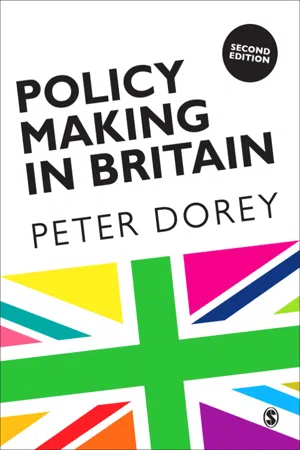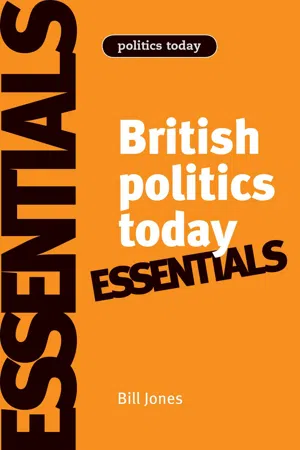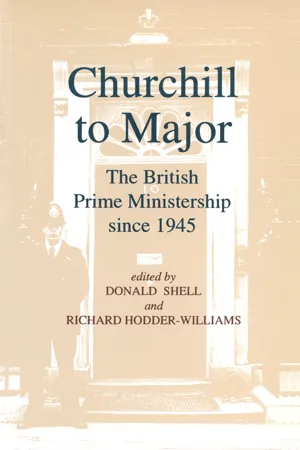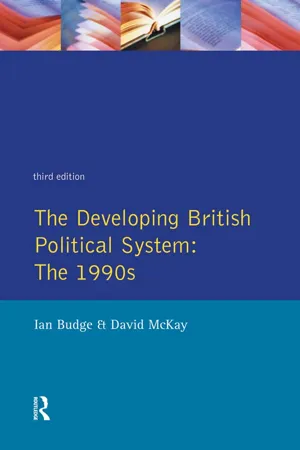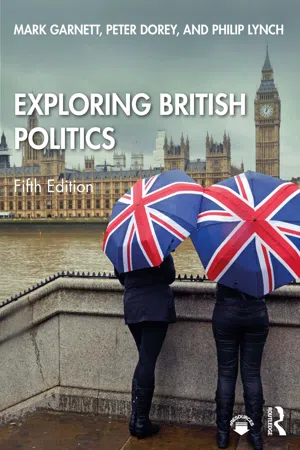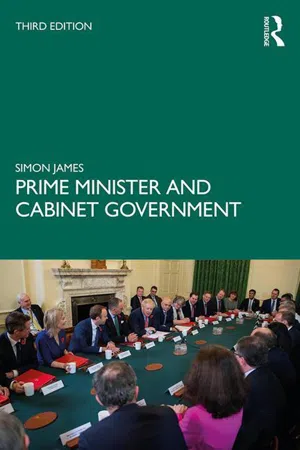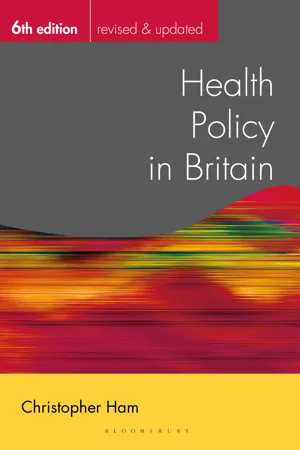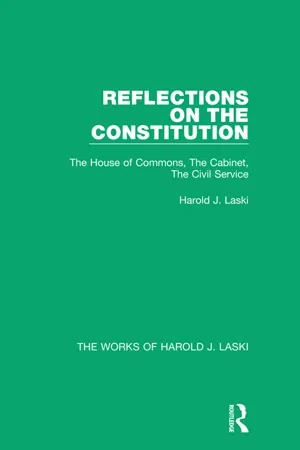Politics & International Relations
The UK Cabinet
The UK Cabinet is a group of senior government ministers chosen by the Prime Minister to lead various government departments and make key decisions. It is the main decision-making body of the government and plays a crucial role in shaping and implementing government policies. The Cabinet meets regularly to discuss and decide on important issues affecting the country.
Written by Perlego with AI-assistance
Related key terms
Related key terms
1 of 4
Related key terms
1 of 3
10 Key excerpts on "The UK Cabinet"
- eBook - ePub
Policy Making in Britain
An Introduction
- Peter Dorey(Author)
- 2014(Publication Date)
- SAGE Publications Ltd(Publisher)
We would suggest that a similar principle applies to significant changes in departmental philosophies or ‘paradigm shifts’, whereby a single minister in post for an average of 18 months or so is usually unlikely to introduce significant or lasting change in the policy perspective of a department. Such change usually requires that s/he is immediately succeeded by a minister who fully shares his/her vision and objectives and can therefore build on the momentum they initiated. The succeeding Minister will also be able to learn from any mistakes made by his/her predecessor, or identify where obstacles or opposition emanated from. Subsequent ministers can then sustain or consolidate the shift in departmental objectives and policy, thereby ensuring that it becomes further embedded and entrenched.THE CABINETComprising 21–23 ministers (including the Prime Minister), the Cabinet was, for much of the 20th century, regarded as the most important arena of decision taking and policy making. However, it is now widely accepted that the policy-making role of the Cabinet has diminished, especially since the 1970s, partly through the transfer of certain powers to the EU, but more importantly because an increasing volume of government business has effectively been delegated down to other policy arenas and modes of ministerial interaction, most notably Cabinet committees, as discussed below.Apart from the Prime Minister, the vast majority of ministers belonging to the Cabinet are heads of key government departments, namely the Secretaries of State and the Chancellor. In addition to these, one or two of the non-departmental Ministers/Ministers without Portfolio are usually appointed to the Cabinet. While most Cabinet Ministers are recruited from the government’s MPs in the House of Commons, a couple or so will be selected from peers in the House of Lords. Also in regular attendance at meetings of the Cabinet is the government’s Chief Whip, who acts as an important conduit of communication between ministers and their backbench colleagues.It is now widely acknowledged that the traditional textbook or constitutional model of the Cabinet acting as a forum for systematic decision taking and detailed discussions concerning government policies is no longer accurate, and has probably not been for quite some time (Burch, 1988a: 30–2; James, 1999: 81–7). The complexities of governing Britain have increased since 1945, with a consequent expansion of governmental responsibilities and a corresponding increase in both the volume and complexity of legislation. - eBook - ePub
British politics today: Essentials
6th Edition
- Bill Jones, Dennis Kavanagh(Authors)
- 2013(Publication Date)
- Manchester University Press(Publisher)
By the nineteenth century this body comprised all the major portfolios and took all the major decisions. By the end of the century the Prime Minister was more than ‘first among equals’, as he was initially seen, and from then on the office acquired more prestige and power. But the Cabinet, too, was enhanced by more authority and prestige, which made it the key body to belong to and the pool of talent from which Prime Ministers were drawn.Size and composition
Cabinet usually comprises twenty to twenty-four ministers but during the two World Wars ‘War Cabinets’ were a quarter of that size. In normal times of peace, they include all the major ministers – Chancellor, Home Secretary, Foreign Secretary, Health, Work and Pensions Ministers, and so forth – but also included are those with the more specialist jobs of Leader of the House, Chief Whip, Leader in the Lords, Attorney General and Lord Chancellor, plus the occasional ‘all purpose’ and archaic portfolios of Lord Privy Seal or Lord President of the Council, who often chair Cabinet committees or perform specific tasks for the Prime Minister. Non-Cabinet ministers also attend by invitation.Collective responsibility
This long-established principle of British government is that once Cabinet has taken a decision, all ministers, including non-Cabinet ones, are obliged to support it even if they personally have reservations about it. As the rule is codified in Questions of Procedure for Ministers (now known as the Ministerial Code ), Cabinet decisions are ‘binding on all members of the government’. Anyone wishing publicly to oppose such a decision or policy is obliged to resign or will be sacked by the Prime Minister. In 1975, Cabinet ministers opposed to Britain’s continued membership of the European Community were allowed, owing to the special circumstances, to dissent from government policy on this course of action. However, more typical was Robin Cook’s resignation over Tony Blair’s policy of invading Iraq in 2003, together with the usual explanatory speech to the Commons, in his case an especially powerful one.Functions of the Cabinet
The Cabinet has the following functions:• Determining policy - eBook - ePub
Asia in the New Millennium
The Parliamentary Cabinet System since 1868
- Brian Woodall(Author)
- 2014(Publication Date)
- The University Press of Kentucky(Publisher)
An established Westminster-style cabinet is the most powerful executive organ, and as such it should be able to act with relative autonomy vis-à-vis the legislature, government bureaucracy, and other potential competitors for executive primacy (Lijphart 1999, 10). The cabinet sets the general course for government policy, acts as the ultimate coordinator and arbiter of last resort in executive affairs, and oversees the various departments of government. In the words of a former British cabinet minister, the cabinet is at the “centre of the web” (Searing 1994, 366). The cabinet sets the agenda for legislative deliberation and sponsors the largest share of policies that are enacted into law. In addition, the cabinet oversees the government bureaucracy, referees inter-ministerial disputes, and reviews and authorizes all major policy decisions (Kavanaugh 2000, 239). Ministers are the supreme authorities within their departments, over which they are individually responsible. At the same time, all ministers are subordinate to the cabinet, which, as a team, possesses powers that are greater than the sum of its parts. The prime minister has the power to appoint and dismiss ministers and, of necessity, plays a role that exceeds that of first among equals. Yet the cabinet’s “consent to major initiatives usually must be obtained, and not even the most determined Prime Minister could prevail against the opposition of his or her colleagues for long” (Thomas 1998, 12). In sum, a Westminster-style cabinet should be firmly entrenched in the center of the central state executive.Finally, a well-established Westminster-style system is the product of an evolutionary process that requires “the capacity to respond to the challenges of time and changing environment; the dropping of old tasks and taking on of new ones and the resolution of succession problems” (Dominguez and Mitchell 1977, 173). For this reason, I perceive organizational age and iterated leadership succession as simple indicators of durability. Indeed, a defining feature of the Westminster system is the broadly embraced legitimacy and irregularity by which prime ministers and cabinet members assume their executive posts, only to be replaced by new prime ministers and cabinets. To endure and continue to fulfill their core functions, cabinets must adapt to the challenges posed by protracted economic downturns, mushrooming government deficits, public health concerns, environmental problems, demographic changes, and natural and manmade disasters. In addition, they must deftly respond to international structural changes (for example, the end of the Cold War), tension in foreign relations, territorial conflicts and challenges to national sovereignty, and homegrown as well as international terrorism. Likewise, they must effectively respond to structural changes or challenges in the political order (such as the advent of coalition governments) and major corruption scandals. - eBook - ePub
Churchill to Major: The British Prime Ministership since 1945
The British Prime Ministership since 1945
- R.L. Borthwick, Martin Burch, Philip Giddings(Authors)
- 2016(Publication Date)
- Routledge(Publisher)
77Other prime ministers have sought to influence cabinet discussion by carefully choosing which ministers to speak when, or by lobbying individual ministers beforehand; these were Callaghan’s tactics on the International Monetary Fund (IMF) loan. Thatcher preferred more direct methods, seeing herself very much as the chief executive, ‘the boss’, and other cabinet members as ‘her’ ministers rather than colleagues.Little hard evidence has yet become available about John Major’s style. The impression given initially was of a much more relaxed collegiality than existed under Thatcher. But Norman Lamont’s resignation statement and Major’s less than complimentary remarks about three of his ‘Euro-sceptic’ cabinet colleagues after the parliamentary battles over the Treaty of Maastricht suggest strong underlying tensions.78The flexibility of Britain’s cabinet system can contain such differences of prime ministerial style. It also enables the business of government to adapt to the variety of circumstances which occur in a fast-changing world. But the system cannot be more efficient than the ministers and officials who operate it. It cannot manufacture decisiveness, certainty or knowledge where there is hesitation, doubt or ignorance, although, with the connivance of ministers and officials, it can present the latter as if it were the former. Here, in short, is a tool for a prime minister to use and like all tools its effectiveness depends on the operator’s skill and the malleability of the material: the people and the issues.The Prime Minister and Cabinet Policy-making
A British prime minister is party leader as well as cabinet chairman. Some party leaders have distinct policy preferences, perhaps amounting to a personal ideology, which they will want to be reflected in the decisions of the government they lead. This is not invariable; some party leaders are – or have to be – content with the task of maintaining the cohesion of the government and demonstrating its general competence, allowing ideas and policy initiatives to emerge from elsewhere. Sometimes the policy preferences of leaders will be known when they are elected, as was Heath’s commitment to Europe. In the case of others, such as Thatcher, they will emerge during their period of office, as will their style of leadership. - eBook - ePub
- Ian Budge, David Mckay(Authors)
- 2014(Publication Date)
- Routledge(Publisher)
Thus, out of political necessity, was born the ‘principle of collegiality’, one of the principles that informs British constitutional practice to this day. The principle had, and has, three linked components. The first was that the ‘best’, the most authoritative, decisions in British government must be collective decisions – decisions of the whole Cabinet, not just of one member of it or of any group of members. The second was that, if the best decisions were to be collective decisions, then the collective’s members had the right to be consulted about the most important of them and to participate in the taking of them. The third was that, collective decisions having been taken, all the members of the Cabinet and the government had the duty to defend them publicly. Political strength lies in unity. The best way of achieving unity, and of increasing the chances that it could be publicly maintained, was collective deliberation. British government was not to be a one-man band; it was to be like an orchestra.This collegial mode of operation, the product of eighteenth- and nineteenth-century political circumstances, is still the dominant norm in the British constitution today. The Prime Minister still has few decisions that (s)he can take alone. The best decisions are still Cabinet decisions; indeed a decision that does not have the Cabinet’s sanction behind it is, in a strict sense, not a decision of the government at all.Moreover, institutions have grown up to reinforce the Cabinet’s collegiality and special constitutional status. The country’s principal civil servant is the Cabinet Secretary. The government’s principal co-ordinating mechanism is the Cabinet Office (not the Prime Minister’s office). The most authoritative record of the government’s decisions is the Cabinet Minutes. Not all government business, even in the upper echelons of Downing Street and Whitehall, is Cabinet business, of course. For reasons of convenience, speed, secrecy and political expediency, much high-level business is transacted by small groups of ministers (some formally constituted as Cabinet committees, some not); by groups of civil servants and ministers meeting together; and by means of ministerial correspondence. But the principal focus of governmental decision-making is still, in the 1990s as it was in the 1790s, the Cabinet.The principle of collegiality also finds expression in the language of Downing Street and Whitehall. Members of a collegial body are, in a literal sense, ‘colleagues’, and that is the word that British Cabinet ministers use in referring to one another. The use of the word ‘colleagues’ implies that Cabinet ministers are associated together in a common political enterprise. It also implies a degree of equality: colleagues are people who work together; they are not people who work for one another. Ministers correspondingly refer to the Cabinet and to the government as a whole as ‘we’. The doctrine that imposes a vow of silence on dissenting Cabinet minsters (unless they care to resign) is the doctrine of ‘collective - eBook - ePub
- Mark Garnett, Peter Dorey, Philip Lynch(Authors)
- 2020(Publication Date)
- Routledge(Publisher)
The prime minister is acknowledged to be the most important figure in British politics, but his or her power is not fixed, and is subject to important constraints. The cabinet takes relatively few decisions, because the details of most policies are decided within its committees. This chapter explores where power lies within the core executive, and assesses developments in the role of prime minister over recent decades, particularly since 1997. The core executive model For much of the twentieth century, an enduring question in the study of British politics was whether the UK had a system of cabinet government or prime ministerial government, and where did political power ultimately reside? Those who emphasised the continuing importance of the cabinet note that the British constitution provides for collective government exercised by senior ministers. In The English Constitution (1867), the highly respected political observer Walter Bagehot described a system of cabinet government in which the prime minister was certainly ‘first among equals’, but far from an all-powerful figure. Virtually 100 years later, G.W. Jones (1965/1985) argued that the prime minister was only as strong as his/her colleagues allowed them to be: the support of the prime minister’s fellow ministers or backbench MPs could, in certain circumstances, be withdrawn, possibly to the extent that s/he would resign, as happened to Margaret Thatcher in November 1990, Tony Blair in 2007, and Theresa May in May 2019. Against this view, advocates of the ‘prime ministerial government’ perspective point to the growth in the powers of the prime minister and the corresponding diminution of the cabinet in the twentieth century. This alleged establishment of prime ministerial government was apparently reinforced by the rise of career politicians who were willing to show obedience to their party leader in order to increase their chances of promotion to ministerial office when in government - eBook - ePub
- Simon James(Author)
- 2020(Publication Date)
- Routledge(Publisher)
Two principal conclusions arise from the way the Cabinet operated in this period. First, its role was almost entirely reactive. That was nothing new. It had been true more often than not in the nineteenth century because the span of government was narrower, issues simpler and time for discussion more plentiful, so the Cabinet could in this time have a significant role in identifying problems requiring action and shaping policy as it evolved. But it was always heavily dependent upon the initiative taken by the responsible departmental minister, and of the Prime Minister if he took an interest in the issue. As described in the previous chapter, the “right of initiative” in the British system of policy-making lies with the departmental minister, and that is the dominant dynamic of the system.As the span of government widened and the complexity of business grew, the Cabinet’s capacity to influence the development of the policy shrank and from 1945 onwards it would on most issues be entirely reactive to recommendations and decisions taken by its committees. It rarely initiated action; at most, it might refer a problem to a committee for study and report back. It did not generate proposals, it responded to them. The Cabinet’s power became essentially negative: it could block, amend or qualify proposals but did not itself initiate policy. The Cabinet was a brake, not a dynamo.Most comparable cabinet systems also went down the road of ever greater devolution to committees. Australia, Canada and New Zealand, who copied their Cabinet systems directly from the UK, certainly did so; so did most Western European countries (Mackie and Hogwood 1985). Those European cabinets that did not found themselves compelled to meet with increasing frequency: by the 1970s and 1980s the Dutch Cabinet was spending between 20 and 30 hours a month in session; so were Scandinavian Cabinets, if informal sessions were taken into account, compared with six to nine hours a month for their French and British counterparts (Andeweg 1985).Second, the very process of putting an issue through Cabinet consideration could mean that, by the time an issue had reached the Cabinet, it might have gained irreversible momentum. Lord Hailsham observed:On matters of importance the Cabinet as such is usually consulted fairly late in the day. The ground has usually carefully been prepared by discussions between civil servants, correspondence between ministers, informal meetings, Cabinet committee meetings … by the time the Cabinet is brought in as a whole, it may wed be that only one decision is possible, even when, had it been consulted at the outset, the policy would have been wholly unacceptable. - eBook - ePub
- Christopher Ham(Author)
- 2009(Publication Date)
- Bloomsbury Academic(Publisher)
Ministers are responsible for the day-to-day running of the government’s business through the departments of state. These departments include the Treasury, which is responsible for all matters to do with the economy and public spending, and the Department of Health (DH). Most of the work of the departments is in practice carried out by civil servants. Ministers are, however, individually responsible for the work done by civil servants in their name, and are held accountable by Parliament. Parliament also monitors the work of government departments through a system of select committees.There is no written constitution in Britain and the relationship between the different institutions of government has evolved over the years. As one of the foremost students of the constitution has observed, the result is a ‘curious compound of custom and precedent, law and convention, rigidity and malleability concealed beneath layers of opacity and mystery’ (Hennessy, 1995, p. 7). In seeking to unravel the mystery of the unwritten constitution, much has been written about the role of the monarchy, the legislature and the executive. To summarise this literature briefly, the historical decline in the power of the monarchy and the House of Lords gave rise to the thesis that Britain had a system of ‘Cabinet government’. In his book, The English Constitution, published in 1867, Walter Bagehot argued that the monarchy and the Lords had become ‘dignified’ elements in the constitution, compared with the Commons, the Cabinet and the Prime Minister which he described as the ‘efficient’ elements (Bagehot, 1963).Almost 100 years later, Richard Crossman, writing an introduction to a new edition of Bagehot’s book, contended that Prime Ministerial government had replaced Cabinet government. In Crossman’s view, the extension of voting to all adults, the creation of mass political parties and the emergence of the civil service administering a large welfare state all contributed to the Prime Minister’s power (Crossman, 1963). This interpretation was confirmed by Crossman’s experience as a Cabinet minister. In addition, he noted the important part played by official committees in Whitehall, a facet of government he had not observed while in opposition; and he encountered the power of civil servants to challenge and frustrate the wishes of ministers. Students of central government have drawn on the experience of the Thatcher and Blair governments to argue that Prime Ministerial government may have become presidential or even Napoleonic (Hennessy, 2005), so powerful have recent incumbents of this office become. - eBook - ePub
Reflections on the Constitution (Works of Harold J. Laski)
The House of Commons, The Cabinet, The Civil Service
- Harold J. Laski(Author)
- 2014(Publication Date)
- Routledge(Publisher)
Mr. Churchill’s good graces. And perhaps I may add, without indiscretion, that it has been even more fascinating, after that defeat of 1945, which shocked him by its unexpectedness, to watch Mr. Churchill himself, though formally the leader of the Opposition in the House of Commons, deal with the problems of the day as though he were the permanent Prime Minister of an invisible government whose duty it was to set the configuration of policy within which Mr. Attlee and his colleagues must organise their activities.Passage contains an image
X AN ALTERNATIVE STRUCTURE
DOI: 10.4324/9781315742533-10Upon this basis, I should argue that the institutional framework of a Cabinet will be at its best when it is primarily composed of those Ministers whose departments must necessarily engage the major attention of the House of Commons. Some attention, of course, must be given to the party status of men who do not choose to be in charge of such Departments; and almost every Cabinet is better off for one or two Ministers whose departmental duties are purely nominal, but who can be trusted either to offer wise general counsel, or to give special help at some point where the weight cast upon a given Minister is too important to be carried by a Parliamentary Under-secretary, and needs to be shared by another Minister whose prestige in the House will satisfy its members that their dignity has been fully consulted. By these criteria the Cabinet, in relation to “those above the line” in Mr. Churchill’s phrase, would, apart from the Prime Minister himself, normally consist of the following Members: the Foreign Secretary, the Chancellor of the Exchequer, the Home Secretary, the Secretaries of State for Commonwealth Relations and for the Colonies, the Ministers of Defence, Education, and Agriculture, of Labour and of Health, the President of the Board of Trade, and two Ministers with none or small administrative duties, such as the Lord President of the Council and the Lord Privy Seal. That makes a Cabinet of fourteen members, though it is possible that, with the growth of nationalised industries a fifteenth Minister will be necessary whose relation to Departments like those of Transport, of Fuel and Power, and of Supply, may come closely to resemble that of the Minister of Defence to the three service Departments. I assume, of course, that such a Cabinet would discuss with Ministers “below the line” any matter in which the work of their Departments were particularly relevant. - eBook - ePub
Making British Defence Policy
Continuity and Change
- Robert Self(Author)
- 2022(Publication Date)
- Routledge(Publisher)
13 This was certainly the view of Blair’s Chief of Staff, Jonathan Powell:Decisions are well made if the right people are in the room and they have all the available facts before them, on paper or orally, if those in the room feel free to challenge propositions and argue, and if the decisions are properly recorded and disseminated.14While it still fulfils a number of important functions, the reality is that a Cabinet consisting of a maximum of 23 ambitious politicians is singularly inappropriate as the ultimate policy-making body in an already ‘overloaded’ system of government.15 Indeed, it is necessary to go back 150 years to find all major issues decided in full Cabinet, with even the Crimean War being delegated to a ‘War Committee’ in 1855–56, Britain’s first regular Cabinet Committee.16 Similarly, the annual Budget is only formally approved by Cabinet while nuclear and intelligence issues do not come before Cabinet at all.Examples of the full Cabinet being excluded from major defence policy decisions are plentiful. Anthony Eden used a carefully selected ‘Suez Committee’ to assist his ill-fated plans to collude with France and Israel to create a pretext to seize the Suez Canal in 1956. Wilson’s secret agreement with Lyndon Johnson’s administration to support sterling in return for a continued British military presence ‘East of Suez’ in 1965 was kept from the entire Cabinet except the Chancellor.17 The Callaghan government’s decision to conduct underground nuclear tests in 1977 was also decided in a highly secret conclave of a few carefully selected senior ministers.18
Index pages curate the most relevant extracts from our library of academic textbooks. They’ve been created using an in-house natural language model (NLM), each adding context and meaning to key research topics.
Explore more topic indexes
Explore more topic indexes
1 of 6
Explore more topic indexes
1 of 4
